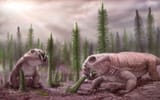Search Results
6/14/2025, 9:45:04 PM
In 2010, Martin A Nowak, Corina E Tarnita and the late Edward O Wilson published a landmark paper on the evolution of eusociality.
In it, they point out that every known instance of eusociality occurred in the context of defending a relatively high-investment nesting- and occasionally feeding site.
Amongst mammals, this is known to have happened twice, with Heterocephalus glaber and Fukomys damarensis.
Both species tend to feed on roots and tubers, and are specialised for digging, creating huge underground networks in which to dig, feed and breed. They also possess peculiar adaptations to deal with low oxygen- and high carbon dioxide concentrations underground.
Unfortunately, it is unlikely that either species is made to last since inbreeding rates are sky-high. Something all eusocial species without flight capability tend to suffer from.
But all of this brings up an interesting speculation.
Lystrosaurus lived in the late Permian and early Triassic. Lived through an era of low oxygen concentrations. Had adaptations for burrowing/digging. Some possessed tusks that could've easily fulfilled the same role as Heterocephalus glaber's enormous front teeth.
None of this HAS to result in the evolution of eusociality, but the conditions to enable it were assuredly there.
There is a timeline out there where one, or perhaps even several, species of Lystrosaurus became eusocial, explaining their staggering abundance in the early Triassic, only for inbreeding to render them extinct again after a few million years.
Maybe it is our timeline.
In it, they point out that every known instance of eusociality occurred in the context of defending a relatively high-investment nesting- and occasionally feeding site.
Amongst mammals, this is known to have happened twice, with Heterocephalus glaber and Fukomys damarensis.
Both species tend to feed on roots and tubers, and are specialised for digging, creating huge underground networks in which to dig, feed and breed. They also possess peculiar adaptations to deal with low oxygen- and high carbon dioxide concentrations underground.
Unfortunately, it is unlikely that either species is made to last since inbreeding rates are sky-high. Something all eusocial species without flight capability tend to suffer from.
But all of this brings up an interesting speculation.
Lystrosaurus lived in the late Permian and early Triassic. Lived through an era of low oxygen concentrations. Had adaptations for burrowing/digging. Some possessed tusks that could've easily fulfilled the same role as Heterocephalus glaber's enormous front teeth.
None of this HAS to result in the evolution of eusociality, but the conditions to enable it were assuredly there.
There is a timeline out there where one, or perhaps even several, species of Lystrosaurus became eusocial, explaining their staggering abundance in the early Triassic, only for inbreeding to render them extinct again after a few million years.
Maybe it is our timeline.
Page 1
